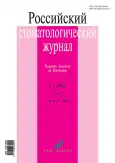Изучение продолжительности ретенционного периода у пациентов с сочетанной патологией окклюзии зубных рядов
- Авторы: Водолацкий В.М.1, Макатов Р.С.1
-
Учреждения:
- Ставропольский государственный медицинский университет
- Выпуск: Том 26, № 5 (2022)
- Страницы: 407-413
- Раздел: Клинические исследования
- URL: https://journals.rcsi.science/1728-2802/article/view/232565
- DOI: https://doi.org/10.17816/dent111817
- ID: 232565
Цитировать
Аннотация
Актуальность. Одной из наиболее тяжелых категорий пациентов детского возраста являются дети с сочетанной патологией окклюзии зубных рядов. В связи с повышением в настоящее время качества и эффективности ортодонтической помощи и уменьшением сроков лечебного этапа у ортодонтических пациентов детского возраста с сочетанной патологией окклюзии возникает необходимость проведения анализа продолжительности ретенционного периода и используемых ретенционных аппаратов.
Цель — изучить продолжительность ретенционного периода у пациентов детского возраста с сочетанной патологией окклюзии зубных рядов.
Материал и методы. Для решения поставленной цели и задач на ортодонтическое лечение было взято 26 детей в возрасте от 6 до 18 лет с патологией окклюзии зубных рядов в двух и трех плоскостях. Все пациенты были поделены на две группы. В 1-ю группу вошли 14 (53,85%) детей от 6 до 16 лет с патологией окклюзии зубных рядов в двух плоскостях. Всем пациентам проводилось ортодонтическое лечение с помощью съемных и несъемных ортодонтических аппаратов. Во 2-ю группу вошли 12 (46,15%) детей от 7 до 18 лет с патологией окклюзии зубных рядов в трех плоскостях.
Результаты. В результате проведенного лечения осуществлен анализ продолжительности ретенционного периода у пациентов детского возраста с сочетанной патологией окклюзии зубных рядов после ортодонтического лечения.
Заключение. Удержание достигнутого результата после устранения сочетанной патологии окклюзии зубных рядов в детском возрасте являлось важным этапом реабилитационного процесса. Во время ретенционного периода, который продолжался в 1-й группе 16–24 мес и во 2-й 19–32 мес, у всех пациентов применялись специально изготовленные для этой цели инактивированные съемные и несъемные ретенционные аппараты.
Полный текст
Открыть статью на сайте журналаОб авторах
Виктор Михайлович Водолацкий
Ставропольский государственный медицинский университет
Автор, ответственный за переписку.
Email: vmv.st@yandex.ru
ORCID iD: 0000-0001-5124-2112
д-р мед. наук, профессор
Россия, СтавропольРуслан Сейфединович Макатов
Ставропольский государственный медицинский университет
Email: Makatov2008@yandex.ru
ORCID iD: 0000-0002-6573-9282
SPIN-код: 6238-7009
ResearcherId: GWV-1997-2022
Россия, Ставрополь
Список литературы
- Johnston C.D., Littlewood S.J. Retention in orthodontics // Br Dent J. 2015. Vol. 218, N 3. P. 119–122. doi: 10.1038/sj.bdj.2015.47
- Zachrisson B.U. Multistranded wire bonded retainers: from start to success // Am J Orthod Dentofacial Orthop. 2015. Vol. 148, N 5. P. 724–727. doi: 10.1016/j.ajodo.2015.07.015
- Littlewood S.J., Millett D.T., Doubleday B., et al. Retention procedures for stabilizing tooth position after treatment with orthodontic braces // Cochrane Database Syst Rev. 2016. N 1. P. CD002283. doi: 10.1002/14651858.CD002283.pub4
- Статовская Е.Е., Петрова Н.П., Ефременко Е.И. Виды ретенционных аппаратов. Санкт-Петербург: СЗГМУ им. И.И. Мечникова, 2016. 36 с.
- Кузнецова М.Ю., Севбитов А.В., Дорофеев А.Е., и др. Анализ результатов ретенции у пациентов, проходящих ортодонтическое лечение на несъемной аппаратуре // Актуальные проблемы медицины. 2020. Т. 43, № 3. С. 412–423. doi: 10.18413/2687-0940-2020-43-3-412-423
Дополнительные файлы












